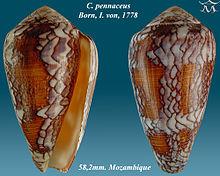| Conus pennaceus | |
|---|---|

| |
| Apertural and abapertural views of shell of Conus pennaceus Born, I. von, 1778 | |

| |
| Scientific classification | |
| Domain: | Eukaryota |
| Kingdom: | Animalia |
| Phylum: | Mollusca |
| Class: | Gastropoda |
| Subclass: | Caenogastropoda |
| Order: | Neogastropoda |
| Superfamily: | Conoidea |
| Family: | Conidae |
| Genus: | Conus |
| Species: | C. pennaceus
|
| Binomial name | |
| Conus pennaceus Born, 1778 [1]
| |
| Synonyms[2] | |
| |

Conus pennaceus, common name the feathered cone or the episcopal cone, is a species of sea snail, a marine gastropod mollusk in the family Conidae, the cone snails and their allies.[2]
Like all species within the genus Conus, these snails are predatory and venomous. They are capable of "stinging" humans, therefore live ones should be handled carefully or not at all.








